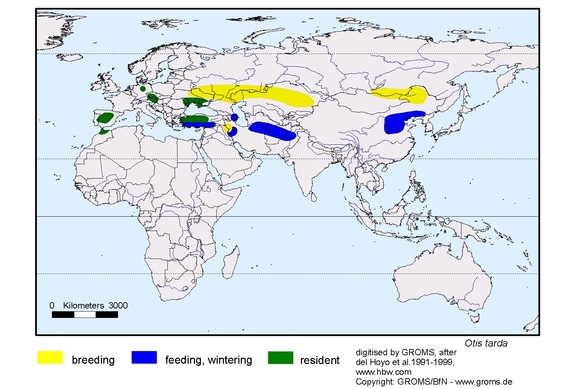| Otis tarda | Linnaeus, 1758 |
| Synonym: | |
| Family: | Otididae |
| Order: | Gruiformes |
| English: | Great bustard |
| French: | Grande Outarde |
| Spanish: | Avutarda euroasiática |
| German: | Großtrappe (There's a German version of this page!) |
| Norwegian: | Stortrappe (There's a Norwegian version of this page!) |
| Migration: | partial migratory in Asia |
| Migration details: | “Largely sedentary or dispersive in Iberia, C & E Europe to Ukraine, depending on severity of winter, and on age and sex, males appearing to move over shorter distances, probably related to degree of maturity. Migratory in Asia, where southward shifts occur, generally over limited distances, from Aug to early winter, with birds returning Mar-Apr.” del Hoyo J, Elliott A, Sargatal J (eds) 1996, Handbook of the birds of the world. Vol. 3: Hoatzin to Auks, p. 263 |
| Regions: | East Asia, Europe, North Africa, North Asia, West & Central Asia |
- digitized by GROMS, after del Hoyo J, Elliott A & Sargatal J (eds) (1996), Handbook of the birds of the world. Vol. 3: Hoatzin to Auks, 821, Lynx Edicions, Barcelona
- Copyright: GROMS/BƒN - www.groms.de
“The great bustard's wide Palaearctic range is becoming increasingly disjunct (Bird Life International 2000). While being largely sedentary or dispersive in Europe and the Ukraine, regular migration is observed in Asia (del Hoyo et al. 1996). Rapid declines throughout eastern and central Europe and Asia have been observed (Bird Life International 2000). The great bustard's population in Germany has declined due to habitat loss during the past 35 years by more than 90% from ca. 1200 birds in 1960 to less than 100 in 1995 (Litzbarski & Litzbarski 1996). The last breeding sites of Otis tarda in Germany, the "Belziger Landschaftswiesen" and the "Havellandisches Luch", are strictly protected, and highly focused management for the benefit of the bustards is promoted (Litzbarski & Litzbarski 1996). Worldwide, key threats are increased human disturbance as well as habitat loss because of agricultural intensification, overgrazing, afforestation and irrigation. Thus, the great bustard is considered "Vulnerable" (VU) in the recent international Red List (Hilton-Taylor 2000) and is included in the CMS Appendices I (Middle-European Pop) & II. A European action plan was published in 1996, and another for East Asian populations in 1998 (Bird Life International 2000).”
Riede, K. (2001): Global Register of Migratory Species. Weltregister wandernder Tierarten. Münster (Landwirtschaftsverlag), p. 253
Further detailed information from the GROMS-database
Recommended link(s):
| ARKive | Great Bustard (Otis tarda): description, pictures, movies... |
| www.greatbustard.com | The UK Great Bustard reintroduction project (as featured on BBC's - 'Saving Planet Earth') (auf Englisch) |
| The European Commission | Europe's most threatend birds |
| www.birdguides.com | |
| BirdLife international | |
| Oiseaux.net | (in French) |
To gather more information about birds in general see the link collection at connotea.org: aves
Please help us by updating our link collection via connotea!
Feedback: mail to: Klaus Riede
by Ansgar Tappenhölter
